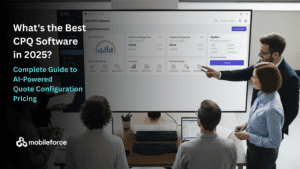
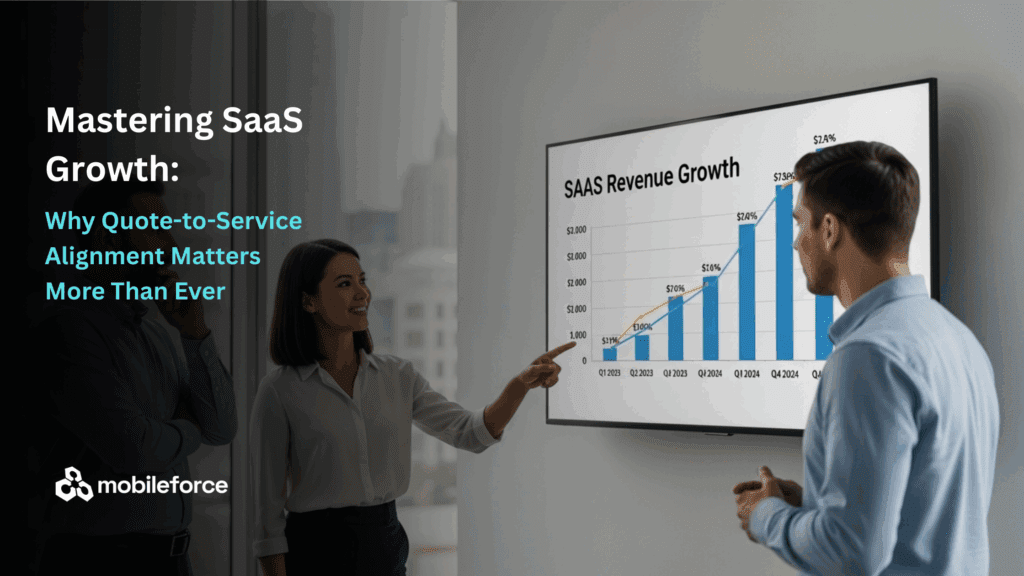
Mobileforce
- General Resources
Table of Contents
ToggleThe Growing Disconnect in SaaS Revenue Operations
The modern Software as a Service (SaaS) landscape presents a critical paradox that’s costing companies millions in lost revenue. While SaaS businesses invest heavily in sophisticated revenue operations and customer success platforms, many still struggle with fundamental alignment issues between their sales and service teams that directly impact their bottom line. This challenge is particularly acute for growing SaaS companies seeking revenue operations alignment best practices and customer retention strategies that actually work.
Key Takeaways:
- Sales departments focus intensively on driving Annual Recurring Revenue (ARR) through quote-to-cash processes
- Service teams concentrate on delivering cloud uptime, seamless onboarding experiences, and comprehensive customer support through quote-to-service workflows
- This operational disconnect creates a dangerous revenue gap that impacts business growth, customer satisfaction, and long-term revenue sustainability for SaaS organizations of all sizes
- Companies with aligned sales-service operations see 36% higher customer retention rates and significantly improved expansion revenue
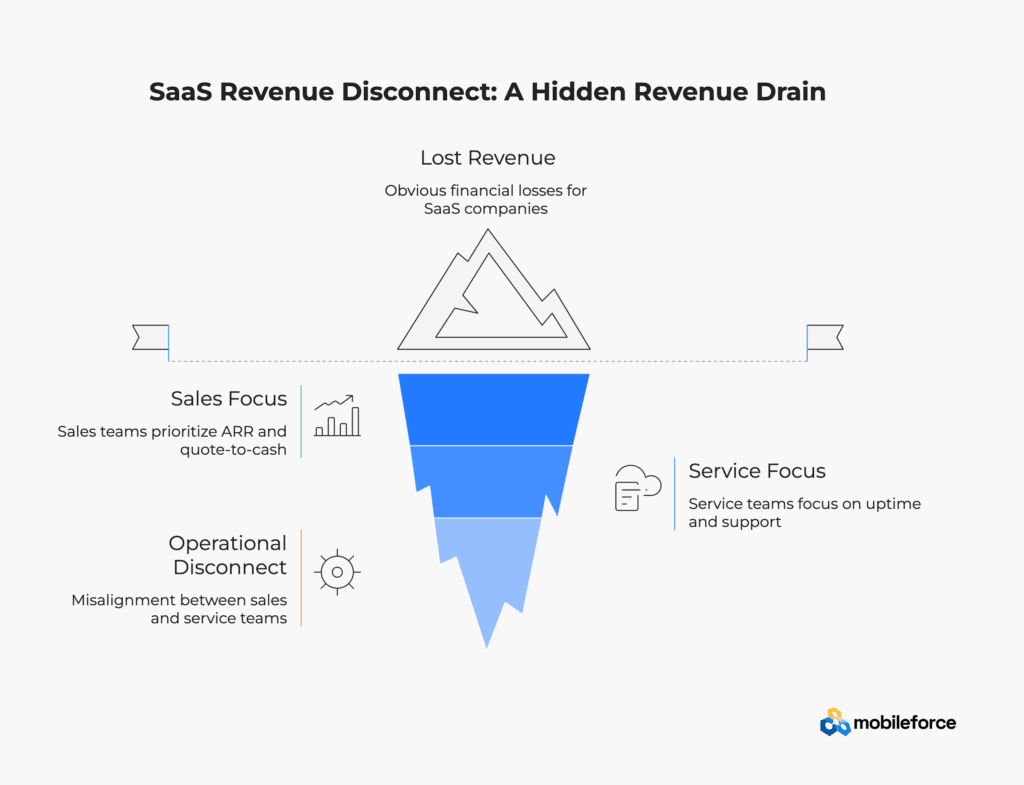
According to 2025 B2B SaaS benchmarks, the average churn rate for B2B SaaS companies is 3.5%, while industry analysis shows that SaaS companies should aim for annual churn rates of no more than 5% to achieve sustainable growth. Recent data indicates that SaaS churn rates dropped to 4.2% in 2024 from 4.4% in 2023, highlighting the critical importance of maintaining strong customer relationships throughout the entire customer lifecycle. Yet despite these concerning statistics, many SaaS organizations continue to operate with fragmented systems that prevent effective collaboration between revenue-generating and service-delivery teams.
💡 Key Insight: Every 1% reduction in churn can increase company valuation by 12% for SaaS businesses – making sales-service alignment a critical growth lever.
The consequences of this misalignment extend far beyond internal inefficiencies. When sales and service teams operate in isolation, companies experience onboarding delays that frustrate new customers, miss critical upselling opportunities during service interactions, and face higher churn rates due to unmet expectations and poor customer experiences.
The Hidden Revenue Leaks in SaaS Operations
Quick Stats: Companies with aligned sales and service teams see 36% higher customer retention and 38% higher sales win rates according to Aberdeen Group research.
Renewals and Expansion Revenue Challenges
One of the most significant missed opportunities in SaaS revenue optimization occurs at the intersection of service delivery and revenue expansion. Service teams interact with customers daily through support tickets, quarterly business reviews (QBRs), and onboarding sessions, yet these touchpoints frequently fail to surface valuable upselling opportunities. This represents a critical gap in SaaS customer retention strategies, as service interactions are prime moments for identifying expansion potential and addressing churn risks before they escalate. When service representatives resolve technical issues or guide customers through feature adoption, they gain intimate knowledge of customer usage patterns, pain points, and growth potential that could inform strategic revenue decisions.
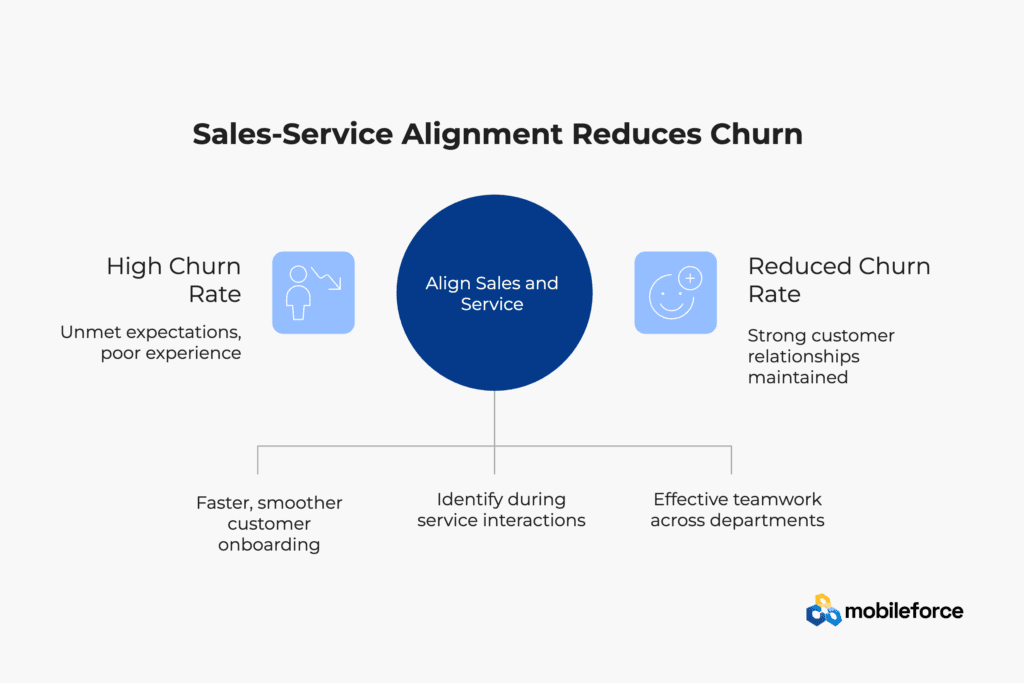
The problem intensifies when considering that new customers tend to expand the most during year one of their tenure, as they ramp up their usage and get fully onboarded. Service teams are uniquely positioned to identify these expansion opportunities, yet without proper systems integration and communication protocols, this valuable intelligence remains trapped within service silos.
⚡ Action Item: Service interactions generate 3x more qualified upsell opportunities than traditional sales prospecting – but only when properly captured and communicated.
Usage-Based Selling Disconnect
Modern SaaS pricing models increasingly rely on usage-based metrics, feature adoption rates, and consumption patterns to drive revenue growth. However, many organizations struggle to connect their Configure, Price, Quote (CPQ) systems with real-time product usage data. This disconnect means sales teams miss critical signals such as feature adoption trends, seat utilization rates, and API usage overages that could trigger timely upselling conversations. For SaaS companies implementing usage-based pricing models, this represents a significant blind spot in their revenue operations alignment best practices.
Pro Tip: Companies implementing intelligent CPQ automation tools can bridge this gap by automatically syncing usage data with pricing models, enabling proactive revenue expansion strategies. This approach is particularly effective for CPQ software for SaaS companies that need to manage complex pricing tiers and usage thresholds.
When sales representatives lack visibility into how customers actually use the product, they cannot make informed recommendations for additional features, higher-tier plans, or expanded usage limits. This blind spot becomes particularly costly when customers exceed their current subscription limits but don’t receive proactive outreach about upgrading their plans.
Reactive Versus Proactive Revenue Management
Traditional service models focus on reactive problem-solving, where teams address issues after they arise rather than identifying opportunities for revenue growth. While resolving customer issues remains essential, forward-thinking SaaS companies recognize that service interactions should also function as strategic touchpoints for identifying commercial opportunities.
Service teams often discover that customers are trying to solve problems that could be addressed through additional product features, premium support tiers, or professional services offerings. Without established processes for capturing and acting on this intelligence, companies miss numerous opportunities to increase customer lifetime value while simultaneously improving customer satisfaction.
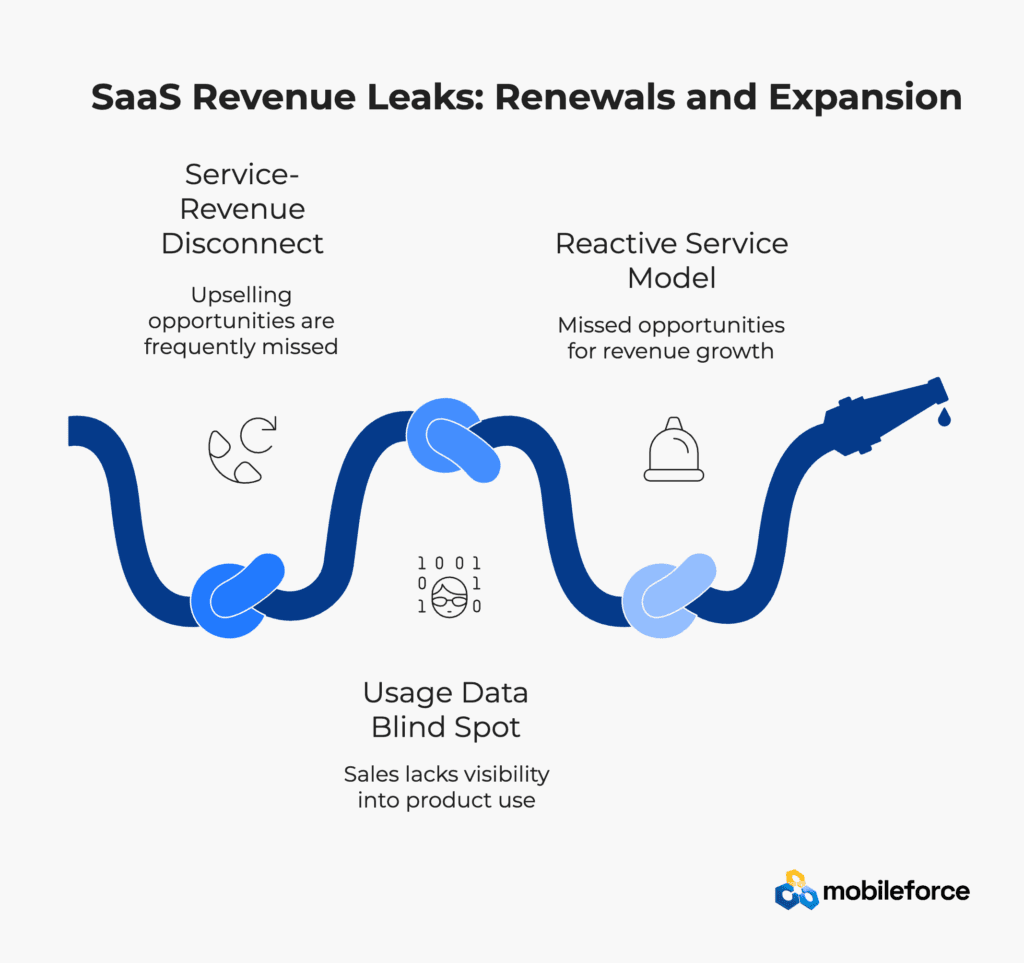
How Organizational Silos Undermine SaaS Growth
The Revenue Impact: Misaligned sales and service teams can cost SaaS companies up to 27% of their potential ARR growth, according to recent industry analysis.
Business Efficiency Challenges
When sales and service teams operate without effective feedback loops, sales representatives often make promises or commitments without fully understanding service delivery capabilities or constraints. For example, sales teams might promise custom integrations, accelerated implementation timelines, or specialized support services without consulting with the service teams responsible for delivery.
This misalignment creates a cascade of problems. Service teams find themselves scrambling to meet unrealistic expectations, potentially compromising quality or requiring additional resources that weren’t budgeted. Meanwhile, customers experience frustration when promised deliverables don’t materialize as expected, leading to decreased satisfaction and increased churn risk.
Customer Experience Impact
The customer experience suffers significantly when internal silos prevent seamless handoffs between sales and service teams. Delayed implementation timelines directly correlate with poor product adoption rates, which in turn increase the likelihood of customer churn. According to 2025 SaaS benchmarks, enterprise SaaS companies should maintain churn rates between 3-5% annually, while smaller SaaS companies can expect 5-7%, making customer experience optimization crucial for sustainable growth.
When customers experience friction during onboarding or encounter service issues that could have been prevented through better sales-service communication, their perception of the entire organization suffers. This negative experience impacts not only immediate satisfaction but also long-term expansion potential and renewal likelihood.
Growth Impact Analysis
The growth implications of sales-service misalignment extend throughout the customer lifecycle. Without established service-to-sales handoff processes, companies routinely miss opportunities to upsell advanced support tiers, specialized analytics modules, or premium onboarding services that could significantly increase per-customer revenue.
Furthermore, when service teams identify customer success patterns or expansion opportunities but lack efficient mechanisms for communicating this intelligence to sales teams, the entire organization suffers from reduced revenue optimization. The cumulative effect of these missed opportunities can substantially impact overall business growth trajectories, making revenue operations automation tools essential for scaling SaaS businesses.
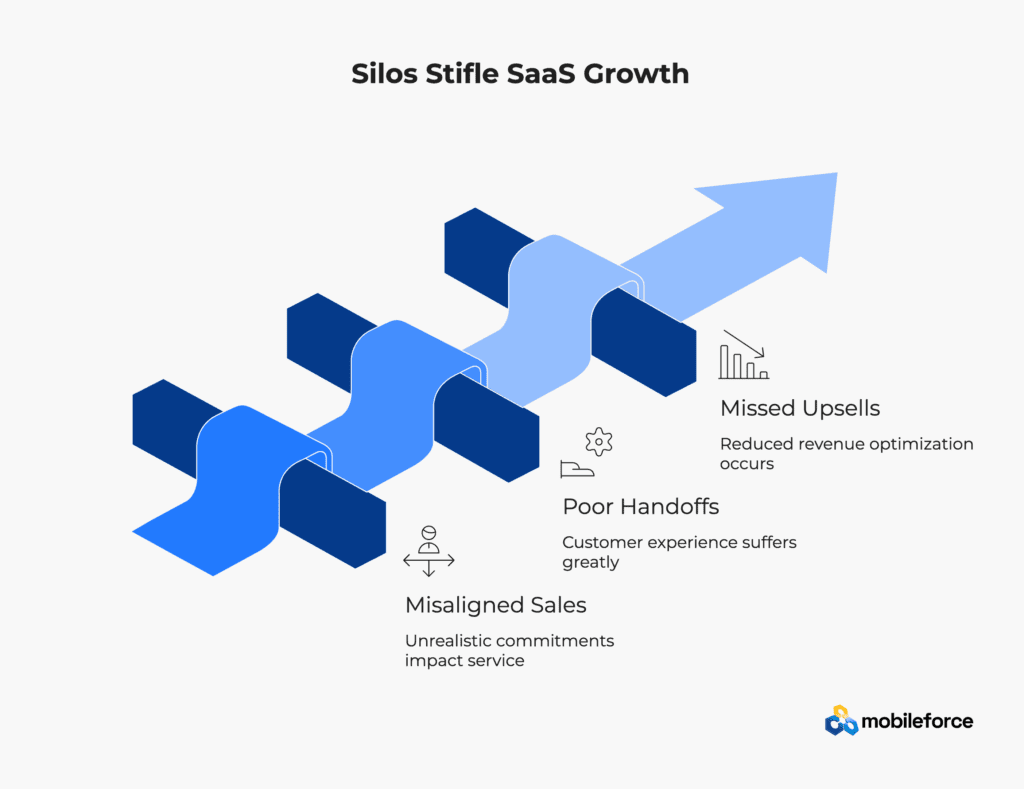
Real-World SaaS Alignment Challenges
Case studies from actual SaaS implementations demonstrate the critical importance of sales-service integration.
CRM Vendor Case Study: The Cost of Misalignment
Consider a CRM vendor whose sales team successfully closes a deal for advanced analytics capabilities, promising sophisticated reporting features and data visualization tools. However, the service team wasn’t involved in pre-sales conversations and discovers during implementation that the customer’s data structure requires significant customization work that wasn’t originally scoped.
The result is customer frustration, delayed implementation, increased service costs, and potential churn risk. Had the sales and service teams been aligned through integrated systems and communication processes, they could have identified these requirements upfront and set appropriate expectations while potentially upselling additional professional services to address the customization needs.
DevOps Platform Scenario
A DevOps platform provider offers usage-based pricing tiers, but their sales and service teams operate with separate data systems. When customers consistently exceed their current usage limits, the service team receives alerts about potential performance impacts, but this information doesn’t automatically trigger sales outreach for plan upgrades.
Customers continue operating above their optimal usage levels, potentially experiencing degraded performance while missing opportunities for plan upgrades that would improve their experience and increase company revenue. The lack of integration between service monitoring and sales processes represents a significant missed opportunity for proactive revenue expansion.
Cybersecurity SaaS Example
A cybersecurity SaaS provider’s service team regularly identifies new compliance requirements or security needs during customer health checks and support interactions. However, without established processes for communicating these insights to sales teams, the company misses opportunities to expand relationships through additional compliance modules, enhanced security features, or specialized consulting services.
These scenarios illustrate how organizational silos prevent companies from maximizing revenue potential while simultaneously limiting their ability to deliver optimal customer experiences.
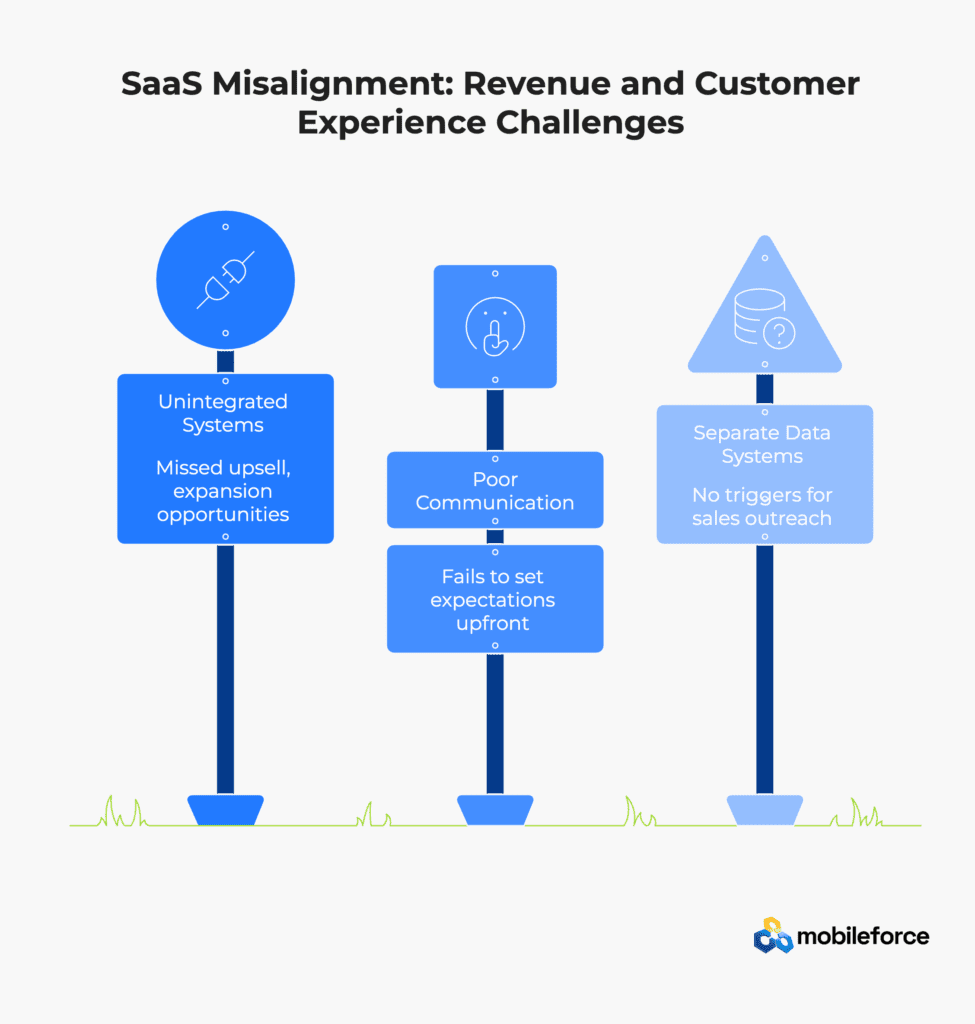
Integration Solutions for SaaS Revenue Optimization
Transform your revenue operations with proven integration strategies that deliver measurable ROI and implement SaaS revenue operations best practices.
CPQ and Service Data Integration
Modern CPQ solutions directly connected to service operations systems (homegrown usage tracking, ServiceNow, or other platforms) deliver real-time, rep-level intelligence that transforms every service interaction into a revenue opportunity. Individual sales reps receive instant alerts when their accounts hit usage thresholds, experience service escalations, or demonstrate expansion signals, enabling immediate action on upsell, cross-sell, and churn prevention opportunities.
Mobile Force Software’s CPQ+ platform provides comprehensive product and service configuration, pricing, quoting, contract generation and approval management capabilities that seamlessly integrates with your back office systems such as Salesforce, Microsoft Dynamics, ServiceNow, SugarCRM, Oracle Sales Cloud, SAP Digital CRM and more, demonstrating how advanced integration capabilities can unify previously siloed operations. This approach exemplifies modern revenue operations automation tools designed specifically for SaaS business models.
When service data flows seamlessly into CPQ systems, sales representatives can create more personalized and relevant proposals based on actual customer usage patterns, support history, and identified expansion opportunities. This data-driven approach improves proposal accuracy and increases the likelihood of successful upsells and renewals.
Ready to see how integrated CPQ can transform your revenue operations? Schedule a personalized demo to discover how Mobile Force Software’s CPQ+ platform can align your sales and service teams for maximum revenue impact. Our experts will show you real-world scenarios specific to your industry and use case.
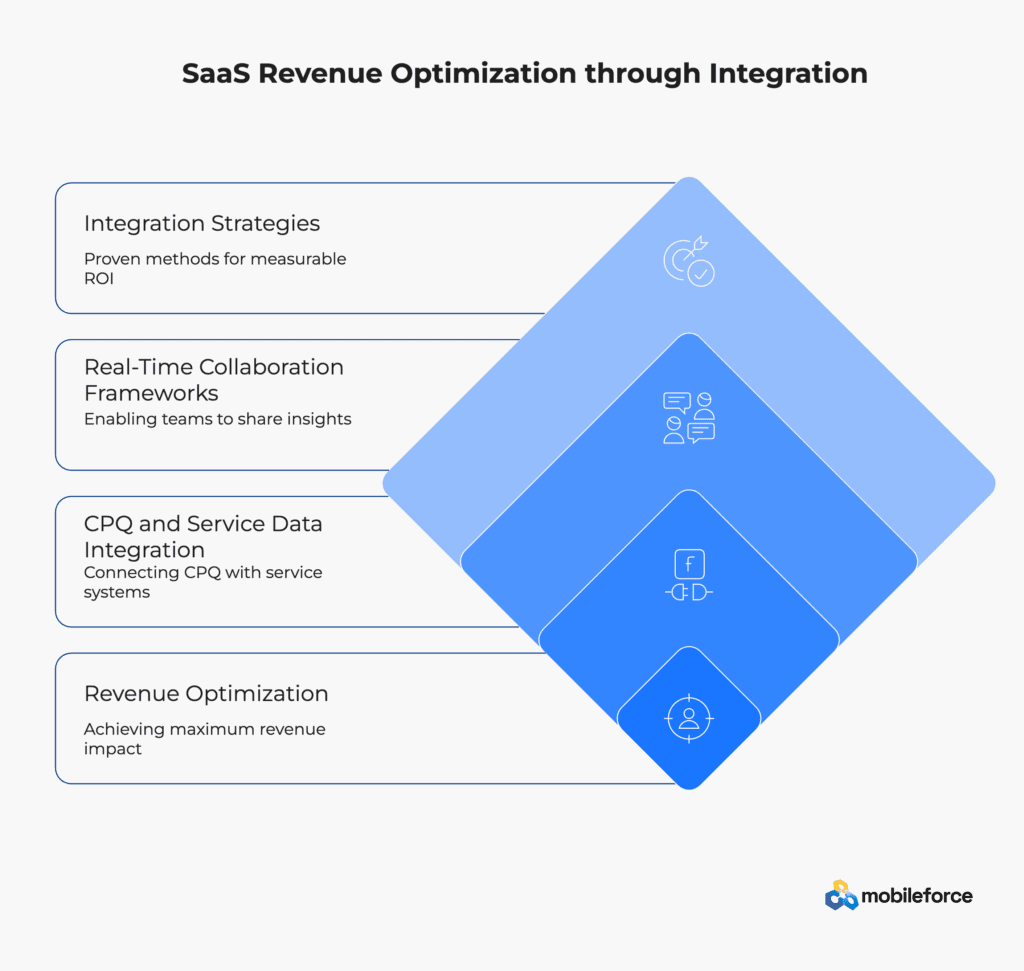
Real-Time Collaboration Frameworks
Effective sales-service alignment requires real-time collaboration capabilities that enable teams to share customer insights, coordinate activities, and jointly identify growth opportunities. No-code CPQ platforms can facilitate this collaboration by providing shared dashboards, automated alerts, and integrated communication tools that keep all stakeholders informed about customer status and opportunities. This represents a fundamental shift toward sales and customer success integration that modern SaaS companies require to remain competitive.
The most powerful implementations feature CPQ platforms with direct API connections to service operations systems, providing sales reps with live dashboards showing usage spikes, support ticket sentiment analysis, and feature adoption patterns for each account in their portfolio.
🚀 Implementation Tip: Start with one integrated dashboard that shows both sales metrics and service health scores – this single view can improve cross-team collaboration by 60%.
When sales teams can see what service teams observe in real-time, they can respond more quickly to expansion opportunities, address potential churn risks, and coordinate activities that improve overall customer experience. This visibility enables more strategic account management and improves the timing of revenue-generating activities, forming the foundation of effective SaaS customer retention strategies.
Revenue Growth Through Integration
Companies that successfully integrate their sales and service operations typically experience improved forecasting accuracy, higher expansion ARR, and reduced churn rates. Recent research shows that top-performing SaaS companies achieve Net Revenue Retention (NRR) of over 120%, with median NRR at 106%, and many of these high-performing companies achieve this through strong integration between their revenue and service delivery operations. These results demonstrate the tangible impact of implementing comprehensive revenue operations alignment best practices.
Integrated systems enable more accurate revenue forecasting by incorporating service-generated intelligence about customer health, usage trends, and expansion potential. This comprehensive view of customer relationships improves both short-term revenue predictions and long-term strategic planning, making it an essential component of modern SaaS revenue optimization strategies.
Rep-Level Revenue Intelligence in Real-Time
SaaS companies can gain a competitive advantage from CPQ platforms that connect directly with service operations to deliver actionable intelligence at the individual rep level. This can happen via:
- Instant Churn Risk Alerts: When service interactions indicate declining satisfaction or usage patterns suggest at-risk accounts, the account owner can receive immediate notifications with recommended retention strategies
- Automated Upsell Triggers: Usage threshold breaches or feature adoption milestones can automatically generate expansion opportunities with pre-calculated pricing in the rep’s queue
- Service-to-Sales Intelligence Flow: Support teams resolving tickets can instantly flag expansion opportunities they discover, routing them directly to the account owner with full context and suggested next steps
Impact Metric: Companies with direct CPQ-service connections can see 47% faster response times to expansion opportunities and identify churn risks 3.2x earlier than those relying on manual processes.
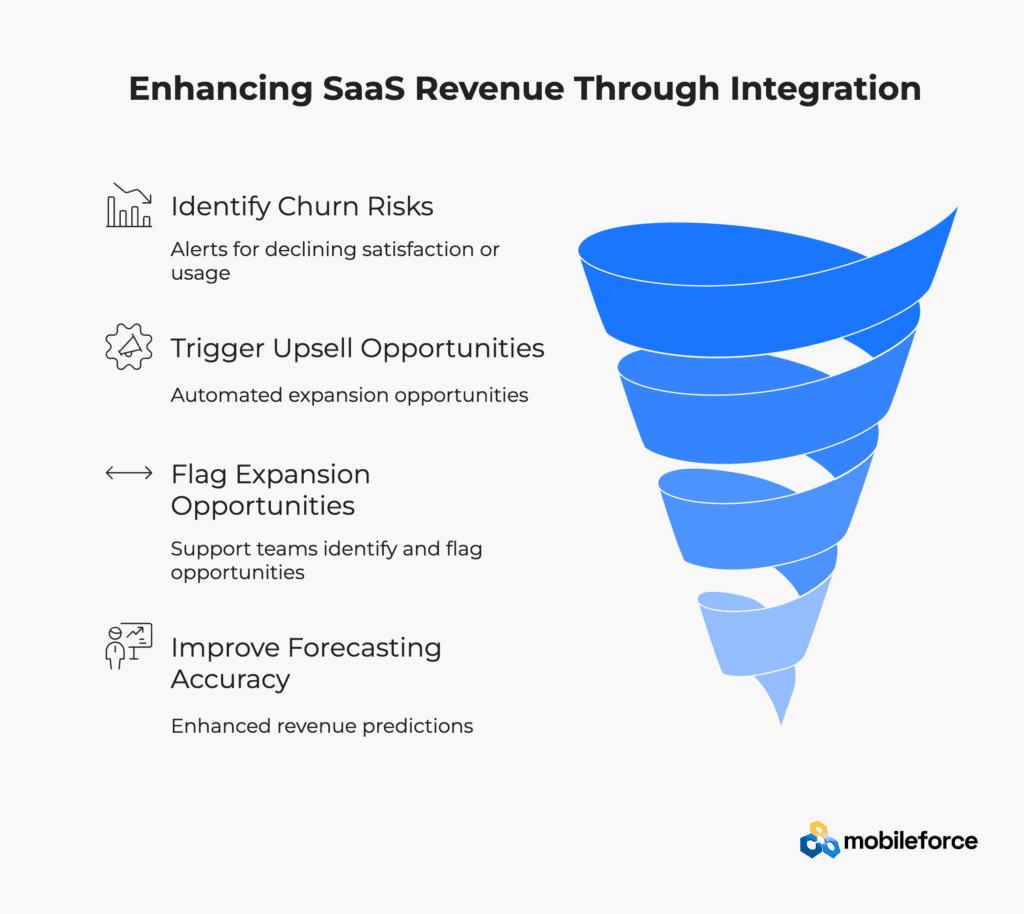
Building a Unified SaaS Growth Engine
The Cost of Inaction
SaaS businesses that fail to address sales-service alignment issues continue bleeding revenue through preventable churn and missed expansion opportunities. According to 2025 SaaS Capital research, the median growth rate for private B2B SaaS companies dropped to 25% in 2024, down from 30% in 2023, suggesting that even successful companies face growth challenges that could be addressed through better operational integration.
The cumulative impact of missed opportunities compounds over time. Each failed upsell, delayed renewal, or churned customer represents not only immediate revenue loss but also reduced lifetime value and diminished growth potential. Companies that continue operating with siloed systems increasingly struggle to compete against more integrated competitors who can deliver superior customer experiences while maximizing revenue opportunities.
📊 Reality Check: The average SaaS company loses $2.4M annually in missed expansion revenue due to poor sales-service alignment – equivalent to 40-50 enterprise customers.
The Future of Integrated Operations
Forward-thinking SaaS companies are implementing integrated CPQ and service connector solutions that transform service touchpoints into strategic growth levers. These platforms enable seamless data flow between systems, automate opportunity identification, and facilitate coordinated activities between sales and service teams.
The future belongs to organizations that can effectively combine operational efficiency with revenue optimization. Companies that invest in integration solutions position themselves to capture more value from existing customer relationships while delivering superior experiences that drive long-term loyalty and expansion.
Long-Term Benefits Realization
Successfully aligned sales and service operations deliver multiple long-term benefits including higher Net Revenue Retention (NRR), stronger renewal rates, and more seamless customer experiences. Companies with effective RevOps automation typically see improved metrics across all aspects of their business, from customer acquisition costs to lifetime value optimization.
The investment in integration technology and process alignment pays dividends through improved operational efficiency, enhanced customer satisfaction, and accelerated revenue growth. Organizations that commit to breaking down internal silos create competitive advantages that become increasingly difficult for competitors to replicate.
Want to explore how your organization can achieve these results? Book a strategic consultation with our revenue operations specialists. We’ll analyze your current sales-service alignment and provide a customized roadmap for integration success.
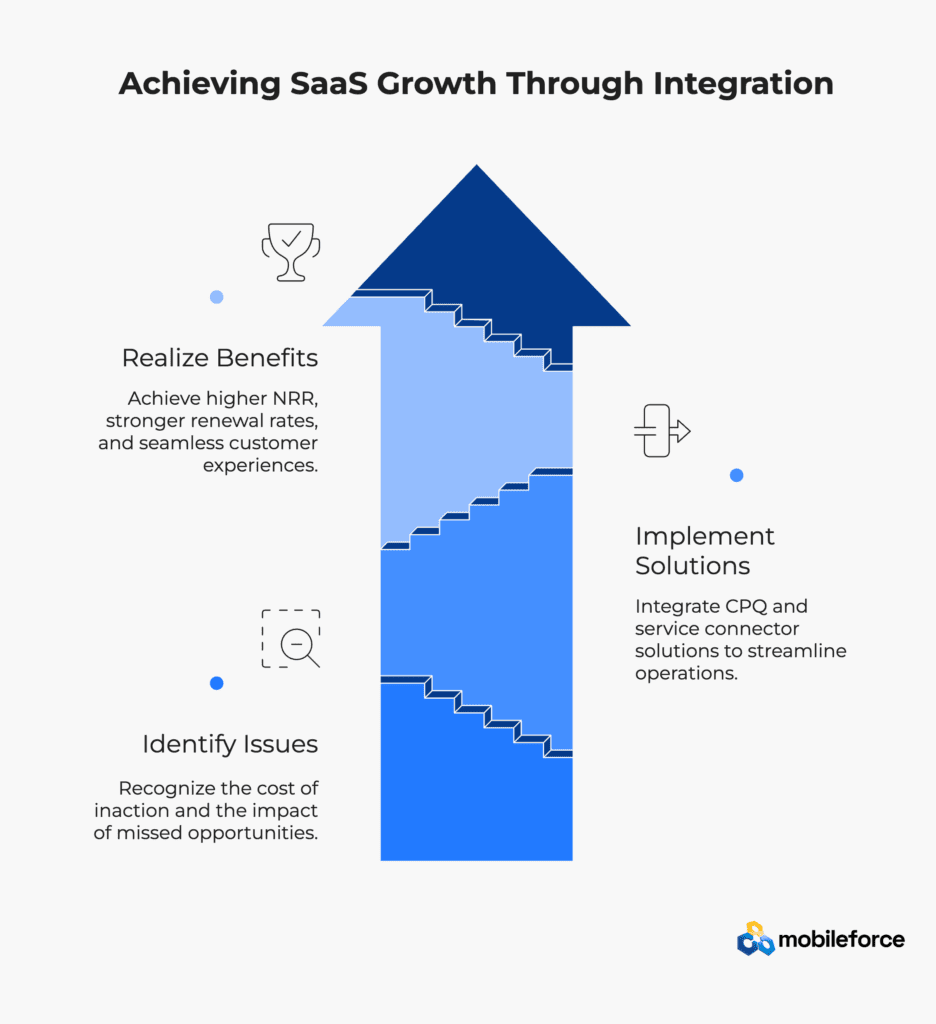
Take Action: Transform Your SaaS Revenue Operations Today
Ready to break down silos and unlock your company’s full revenue potential? Contact Mobile Force Software to learn how our integrated CPQ+ platform can align your sales and service teams for maximum growth impact.
Frequently Asked Questions
What is the main cause of sales-service misalignment in SaaS companies?
The primary cause is the lack of integrated systems and communication processes between sales and service teams. When teams use separate tools and follow different workflows without shared visibility into customer data and interactions, misalignment becomes inevitable. Studies show that 67% of revenue operations teams struggle with data silos across departments.
How can CPQ integration help reduce customer churn?
CPQ integration provides sales teams with comprehensive customer intelligence from service interactions, enabling more personalized renewal conversations and proactive identification of potential churn risks. Companies using integrated CPQ systems report 23% lower churn rates compared to those with disconnected sales and service platforms. When sales representatives understand customer usage patterns and service history, they can address concerns before they lead to cancellations.
What metrics should SaaS companies track to measure sales-service alignment?
Key metrics include Net Revenue Retention (NRR), time-to-value for new customers, upsell conversion rates, customer satisfaction scores, and the percentage of service-generated leads that convert to expansion revenue. Additional metrics include first-call resolution rates, average deal size growth, and cross-functional collaboration scores. These metrics provide insights into how effectively teams collaborate to drive growth.
How long does it typically take to see results from sales-service integration initiatives?
Most companies begin seeing initial improvements in communication and process efficiency within 60-90 days of implementation. However, measurable impacts on revenue metrics like NRR and expansion rates typically become evident after 6-12 months as integrated processes mature and teams adapt to new workflows. Early wins often include improved lead response times and better customer handoff processes.
What are the most common obstacles to implementing sales-service integration?
Common obstacles include resistance to process changes (cited by 45% of implementations), data quality issues, lack of executive sponsorship, inadequate training, and choosing integration solutions that don’t align with existing business processes. Success requires strong change management and commitment from leadership across both departments. Technical challenges like API limitations and system compatibility also frequently arise.

